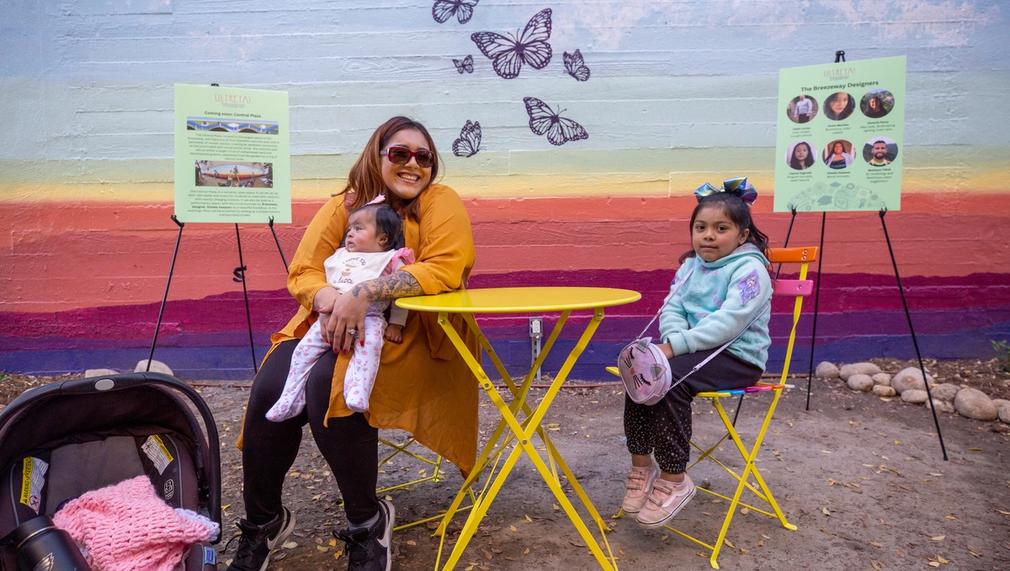Green Your Neighborhood!
Everyone needs safe green space where they can relax and renew. Kid City's Breezeway, designed by first-generation students, includes a native garden, outdoor furniture, mosaics, and a vibrant mural. This project builds a virtual and real-life learning tool using the Breezeway model as a living laboratory to transform unused public spaces into green community hubs. We will show how community members can drive project conception, design, and build. Green space should not be a luxury. Let's give young people the tools to green their neighborhood!

What is the primary issue area that your application will impact?
Green Space, Park Access, and Trees
In which areas of Los Angeles will you be directly working?
Central LA
In what stage of innovation is this project, program, or initiative?
Expand existing project, program, or initiative
What is your understanding of the issue that you are seeking to address?
The need for free access to green spaces has accelerated. Kid City's 2023 YPAR cohort found that families surveyed had reduced recreational activities, vital to mental and physical well-being, in order to pay increasing rent. Kid City students concur, and have repeatedly noted the need for more peaceful outdoor spaces like our new "Breezeway." Kid City participants and Breezeway designers are representative of multi-generational families in metro Los Angeles; they are first generation students from low-income, mixed-status families with little or no access to safe, green, outdoor space. Per the LA County Parks Needs Assessment, metro Los Angeles has a "very high need" for parks. Residents said "...they need more shade and access to water; more ... spaces where they feel safe and welcome; more trails, campgrounds and greenspace..." At the same time, the metro area has "High Regional Recreation Need, with vulnerable populations in many of the communities in this study area."
Describe the project, program, or initiative this grant will support to address the issue.
Green Your Neighborhood uses the Breezeway as a model and teaching tool for community development of public space. As Kid City lives into its first year of programs in the Breezeway, this demonstration project will document the way green outdoor space brings people together in new ways - preschoolers next door, residents of three adjacent affordable housing complexes (designated for persons with disabilities, seniors, and families), the students who created and maintain it, and their family members. Programs may include: art and gardening workshops, demonstrations by and for architecture and design students, and community gatherings. The space may also be used for personal reflection, study, and informal gatherings. New features will teach new concepts: mosaics designed using biomimicry, vertical low-water gardens, sustainable water features, and shade. Interns from ASU's Learning Futures Studio will create an immersive virtual teaching tool that will document the development of the Breezeway from conception to every day use. It will demonstrate how high school and college students learn geometry, math, botany, design, research, and community facilitation skills - all to bring a multi-purpose green space to life. Educators will see how dual enrollment in architecture courses opens up STEM careers to high school students. CBO's and public entities will learn how they can collaborate to give constituents the power to design, build, and maintain their own public green spaces.
Describe how Los Angeles County will be different if your work is successful.
CBOs and public entities will collaborate to provide funding and land for green spaces in every neighborhood. Beautiful gardens with trees and native plants, designed to serve hyper-local needs of nearby residents will replace abandoned lots filled with trash. As Los Angeles residents conceptualize, design, and work together, pride and ownership of public green spaces will become the norm. Educational institutions and affiliated professional organizations will work together to introduce students of all ages to the tools to build the green spaces that fit the needs of their own neighborhoods. Students from historically underrepresented communities will be motivated, as they themselves take part in the creation of these spaces, to enter design, building, and architecture fields in greater numbers. Community space in central and south Los Angeles will be transformed.
What evidence do you have that this project, program, or initiative is or will be successful, and how will you define and measure success?
The Breezeway space, usable since May, has already proved to be a place where students, alumni, and local residents relax and recharge. Students are taking ownership - helping to maintain and refine landscaping. Staff feel revived after spending 30 minutes outside, over lunch, or just meeting with students. Professor Marcela Oliva is showing the Breezeway to colleagues and students to demonstrate a successful community design project. Breezeway designers whose college applications were strengthened by their Breezeway experience have enrolled in UCR and Caltech. Other Breezeway designers have obtained internships in the field. Future measures for success will include the number of people visiting the space, the length of time they spend in the space, and the number of students and professors who access the virtual platform. The ultimate impact will be the development of more spaces like the Breezeway that bring safe outdoor recreational space to low-income communities that lack it.
Approximately how many people will be impacted by this project, program, or initiative?
Direct Impact: 250
Indirect Impact: 5,000
Describe the role of collaborating organizations on this project.
Kid City worked closely to develop the Breezeway with Professor Marcela Oliva at LATTC Architecture and Environmental Design Program. She is a board member for USGBC LA, USC Architecture and Advocacy Program, Pando. She is currently working with ASU Immersive Narrative Program to catalyze multiple green/eco corridors in the city. Her expertise is community engagement for 30 years and community design strategies have worked smoothly and synergistically with our team. She and Urban Foundation/Kid City director Anne Hawthorne work closely together to maximize community input and ownership. Her students end up in the field and transferring to higher education institutions. Students get industry certifications and participate in local, city and national events through this collaboration!